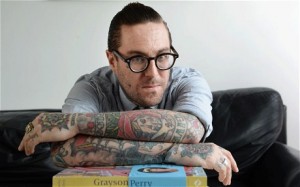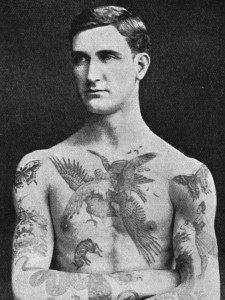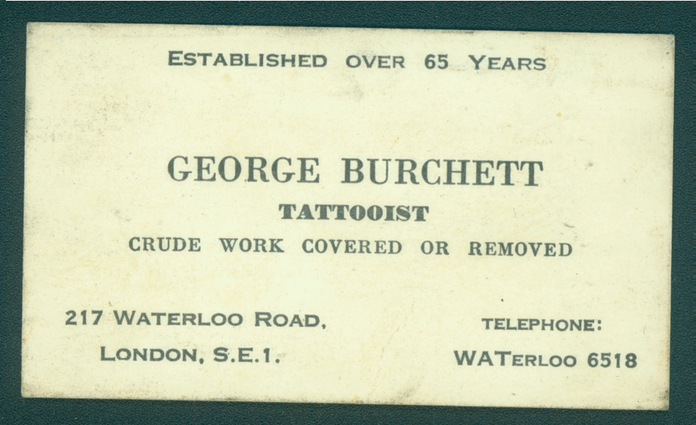The new edition of the Oxford Dictionary of National Biography adds new biographies of 93 men and women active between the fourteenth and twentieth century. The Dictionary of National Biography (DNB) is the national record of men and women who’ve shaped all walks of British life, in the UK and overseas, from the Roman occupation to the 21st century.
 The new edition includes the late-Victorian pioneers of professional tattooing, in an era when tattoos became popular among members of high society and royalty — as symbols of travel to the Far East. Both entries were written by art historian (and Things&Ink favourite) Dr Matt Lodder of the University of Essex (left). Here’s what he had to say: “It was a real honour to be asked to write entries on Burchett and Macdonald for the Oxford National Dictionary of Biography, and to cement their places in the cultural history of this country. As key figures in the early decades of the professional tattoo industry in Britain, and as innovators respected around the world, both men have played a central role in establishing the huge importance of tattooing as part of our shared artistic heritage.”
The new edition includes the late-Victorian pioneers of professional tattooing, in an era when tattoos became popular among members of high society and royalty — as symbols of travel to the Far East. Both entries were written by art historian (and Things&Ink favourite) Dr Matt Lodder of the University of Essex (left). Here’s what he had to say: “It was a real honour to be asked to write entries on Burchett and Macdonald for the Oxford National Dictionary of Biography, and to cement their places in the cultural history of this country. As key figures in the early decades of the professional tattoo industry in Britain, and as innovators respected around the world, both men have played a central role in establishing the huge importance of tattooing as part of our shared artistic heritage.”
Here’s a snippet from the entries:
- Sutherland Macdonald (1860-1942) began tattooing in the garrison town of Aldershot, Hampshire, as early as 1882. He was established as the first identifiable professional tattooist in England by 1889. In this year he first appeared in the London press as a fully-fledged (albeit part-time) tattooer to the general public, working out of the basement of the ornate Hamam Turkish Baths at 76 Jermyn Street—a street well known for its parade of gentlemen’s clubs and fashionable shops. He was employed as the bath’s superintendent, and undertook his tattooing out of hours.Macdonald claimed to have coined the term ‘tattooist’, a contraction of ‘tattoo artist’, to distinguish his practice from that of a mere ‘tattooer’, which he suggested associated his new profession too closely with the workaday business of a ‘plumber’ or a ‘bricklayer’. In 1894 the Post Office Directory for London created the category of ‘Tattooist’ specifically for him, under which Macdonald was the only entry for four years. Sutherland Macdonald continued working as a tattooist into his 70s. However, his pioneering career was posthumously obscured by his children who (on his death certificate) gave their father’s profession not as ‘tattooist’ but ‘Water Colour Artist’.
An example of Sutherland Macdonald’s work, 1897 (Alamy)
- George Burchett (1872–1953), was Macdonald’s ‘rival’ artist and emerged as Britain’s best-known tattooist, having first encountered the art form on a tour of Japan with the Royal Navy. Burchett made a good living producing finely rendered, beautifully detailed work that exceeded all his peers in terms of quality. Between 1914 and 1947 Burchett worked from a studio on Waterloo Road, London.Burchett became the most famous European tattoo artist of the twentieth century, appearing so often in newspapers and magazines that he became recognizable as the archetype of his profession. By the 1930s he had amassed a client list which reputedly included Alfonso XIII, the exiled king of Spain, and Frederik IX, the rough-hewn king of Denmark. His most notorious client was the former army officer Horace Ridler, who in 1927 asked Burchett to tattoo his entire body and face with broad black stripes and swirls. He was still working in 1952 at the age of 80, tattooing ten-bob dragons and indelible make-up in premises at 125 Waterloo Road.


One Reply to “Sutherland Macdonald and George Burchett added to DNB”